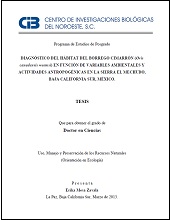Mostrar el registro sencillo del ítem
Diagnóstico del hábitat del borrego cimarrón (Ovis canadensis weemsi) en función de variables ambientales y actividades antropogénicas en la Sierra el Mechudo, Baja California Sur, México.
| dc.contributor | PATRICIA GALINA TESSARO | |
| dc.contributor | ENRIQUE TROYO DIEGUEZ | |
| dc.creator | ERIKA MESA ZAVALA | |
| dc.date | 2013-03-07 | |
| dc.identifier | http://cibnor.repositorioinstitucional.mx/jspui/handle/1001/141 | |
| dc.identifier.uri | http://dspace.cibnor.mx:8080/handle/123456789/2192 | |
| dc.description | El borrego cimarrón, Ovis canadensis, es una especie con alto valor ecológico y cinegético. La distribución de esta especie está naturalmente fragmentada por sus requisitos de hábitat y por las actividades humanas. Baja California Sur es el límite sur de distribución de la especie, donde los asentamientos humanos son mínimos, aislados y asociados generalmente a fuentes de agua y caminos principales. Las actividades humanas sobresalientes en la Sierra El Mechudo son minería, ganadería y cacería. Esta investigación tuvo como objetivo, identificar las actividades humanas que se realizan en la sierra y su efecto sobre la presencia del borrego cimarrón y su hábitat, incluyendo topografía, vegetación y cuerpos de agua superficial. El estudio se realizó en la Sierra El Mechudo, que incluye los ejidos Tepentú, Ley Federal de Agua No. 2 y Ley Federal de Agua No. 3. Se aplicaron encuestas para evaluar las actividades que realizan los pobladores y empresas que se ubican en el área; se caracterizó el hábitat, la distribución y actividad del borrego cimarrón y los ungulados introducidos. Toda la información se compiló para obtener el índice de naturalidad para la sierra. Dentro de los resultados se obtuvo que la percepción de los pobladores hacia la naturaleza es armónica, posiblemente ocasionado por la falta de servicios públicos y el bajo nivel socioeconómico. La distribución de los asentamientos humanos no se relaciona con los sitios de avistamiento de borrego cimarrón. La actividad ganadera (vaca, burro, chivo) es extensiva, abarcando parte del hábitat natural del borrego cimarrón, principalmente en las zonas con disponibilidad de agua libre. La actividad antropogénica más relevante es la minería, aunque sólo modifica el hábitat localmente. La actividad turística es limitada hasta el momento. La principal actividad relacionada con el borrego cimarrón es la cacería deportiva, se realiza dentro de las Unidades para la Conservación, Manejo y Aprovechamiento Sustentable de la Vida Silvestre, las cuales aparentemente no han aportado los beneficios económicos y ambientales esperados. En conjunto, el índice de naturalidad destacó que la zona más natural es la que incluye topografía escarpada; los valores intermedios se encuentran en los sitios con asentamientos humanos y servicios públicos limitados; y las más afectadas son las zonas con influencia de actividad minera. | |
| dc.description | The bighorn sheep, Ovis canadensis, is a species with high ecological and hunting value. Its distribution is fragmented naturally by its habitat requirements and by human activities. Baja California Sur is the southern distribution limit of the species, where human settlements are minimum, isolated, and generally associated to water sources and main roads. The outstanding human activities in Sierra de El Mechudo are mining, livestock, and hunting. The objective of this research was to diagnose human activities performed in the Sierra and their effect on the presence of bighorn sheep and its habitat, including topography, vegetation, and superficial water bodies. The study was performed in Sierra El Mechudo, which includes the common lands Tepentú, Ley Federal de Agua No. 2, and Ley Federal de Agua No. 3. Surveys were applied to assess the activities performed by settlers and companies located in the area; we characterized the habitat, distribution, and activity of bighorn sheep and introduced species. All the information was compiled to obtain the natural index for the Sierra. The results showed that settlers have a harmonic perception towards nature, possibly caused by the lack of public services and the low socio-economical level. The distribution of human settlements is not related with bighorn sheep sighting sites. Livestock activity (cow, donkey, goat) is extensive, covering part of the natural habitat of bighorn sheep, mainly in the areas with free available water. The most relevant anthropogenic activity is mining although it only modifies the habitat locally. Tourism activity is limited at the moment. The main activity related with bighorn sheep is sport hunting, performed within the Units for Conservation, Management, and Exploitation of Wild Life, which apparently have not provided the expected economic and environmental benefits. All together, the natural index highlighted that the most natural area is the one that includes steep topography; the intermediate levels are found in sites with human settlements and limited public services; and the most affected areas are those with the influence of mining activity. | |
| dc.format | application/pdf | |
| dc.language | spa | |
| dc.publisher | Centro de Investigaciones Biológicas del Noroeste, S.C. | |
| dc.rights | info:eu-repo/semantics/openAccess | |
| dc.rights | http://creativecommons.org/licenses/by-nc-nd/4.0 | |
| dc.subject | info:eu-repo/classification/AUTOR/Sierra El Mechudo; borrego cimarrón; actividad antropogénica; variables ambientales | |
| dc.title | Diagnóstico del hábitat del borrego cimarrón (Ovis canadensis weemsi) en función de variables ambientales y actividades antropogénicas en la Sierra el Mechudo, Baja California Sur, México. | |
| dc.type | info:eu-repo/semantics/doctoralThesis |

